BUACC5931 Research Report: Quantitative and Qualitative Job Insecurity
VerifiedAdded on 2022/09/22
|12
|2864
|36
Report
AI Summary
This report analyzes a research study investigating the associations between quantitative and qualitative job insecurity and employee well-being within the Belgian banking sector. The study, conducted by De Witte et al. (2010), involved surveying a sample of 15,000 employees (approximately 21% of the total workforce) across 63 banks. The report delves into key aspects of the research, including the rationale for the sample size, the use of random sampling methods, and the importance of reliability and validity in the study's design. It also examines the role of demographic data as control variables and discusses the quantitative correlational research design employed, including its advantages and disadvantages. The study aimed to establish the relationship between job insecurity, job satisfaction, and psychological distress, providing insights into the impact of workplace conditions on employee well-being. The report highlights the methodologies used for data collection, the statistical approaches employed, and the implications of the findings.
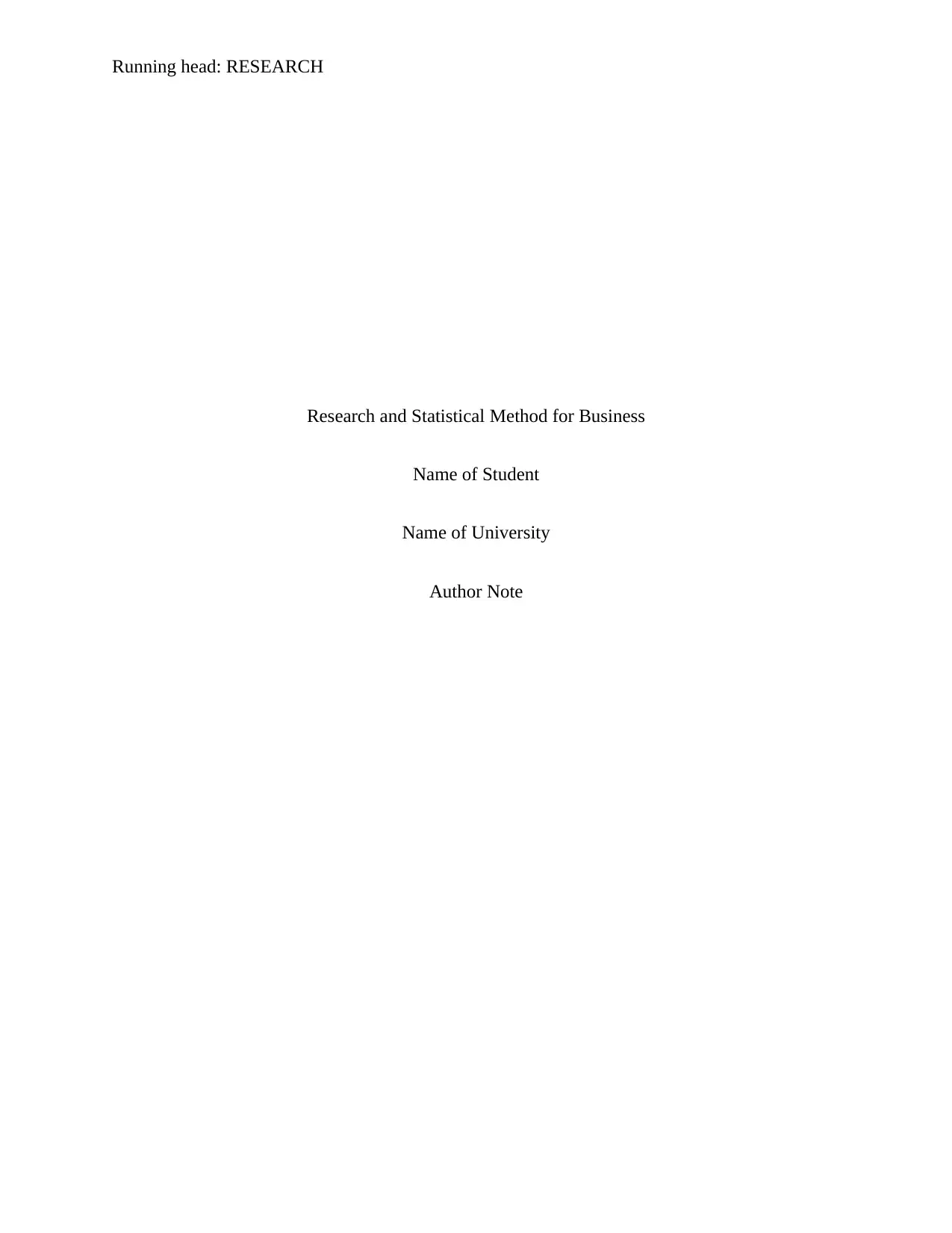
Running head: RESEARCH
Research and Statistical Method for Business
Name of Student
Name of University
Author Note
Research and Statistical Method for Business
Name of Student
Name of University
Author Note
Paraphrase This Document
Need a fresh take? Get an instant paraphrase of this document with our AI Paraphraser
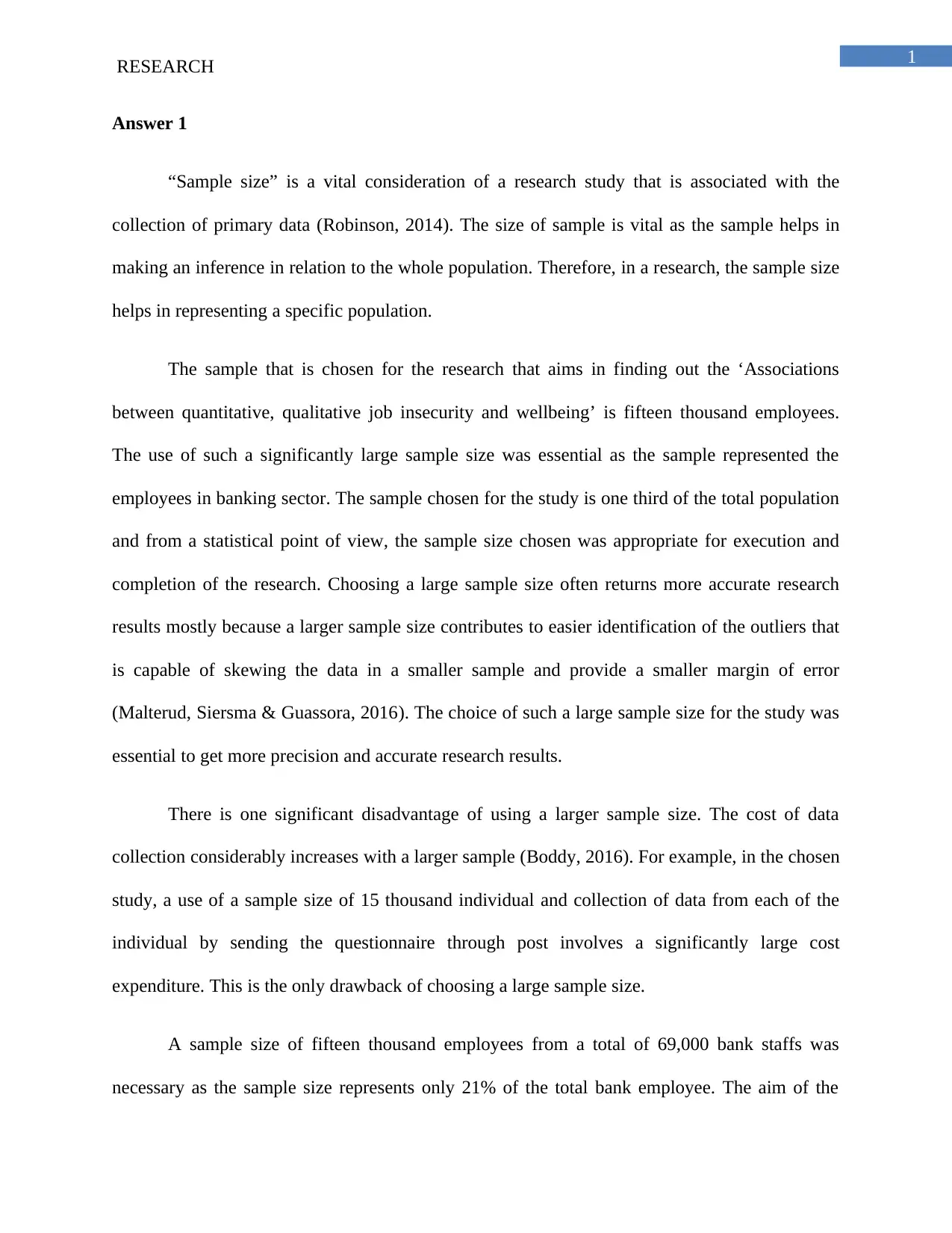
1
RESEARCH
Answer 1
“Sample size” is a vital consideration of a research study that is associated with the
collection of primary data (Robinson, 2014). The size of sample is vital as the sample helps in
making an inference in relation to the whole population. Therefore, in a research, the sample size
helps in representing a specific population.
The sample that is chosen for the research that aims in finding out the ‘Associations
between quantitative, qualitative job insecurity and wellbeing’ is fifteen thousand employees.
The use of such a significantly large sample size was essential as the sample represented the
employees in banking sector. The sample chosen for the study is one third of the total population
and from a statistical point of view, the sample size chosen was appropriate for execution and
completion of the research. Choosing a large sample size often returns more accurate research
results mostly because a larger sample size contributes to easier identification of the outliers that
is capable of skewing the data in a smaller sample and provide a smaller margin of error
(Malterud, Siersma & Guassora, 2016). The choice of such a large sample size for the study was
essential to get more precision and accurate research results.
There is one significant disadvantage of using a larger sample size. The cost of data
collection considerably increases with a larger sample (Boddy, 2016). For example, in the chosen
study, a use of a sample size of 15 thousand individual and collection of data from each of the
individual by sending the questionnaire through post involves a significantly large cost
expenditure. This is the only drawback of choosing a large sample size.
A sample size of fifteen thousand employees from a total of 69,000 bank staffs was
necessary as the sample size represents only 21% of the total bank employee. The aim of the
RESEARCH
Answer 1
“Sample size” is a vital consideration of a research study that is associated with the
collection of primary data (Robinson, 2014). The size of sample is vital as the sample helps in
making an inference in relation to the whole population. Therefore, in a research, the sample size
helps in representing a specific population.
The sample that is chosen for the research that aims in finding out the ‘Associations
between quantitative, qualitative job insecurity and wellbeing’ is fifteen thousand employees.
The use of such a significantly large sample size was essential as the sample represented the
employees in banking sector. The sample chosen for the study is one third of the total population
and from a statistical point of view, the sample size chosen was appropriate for execution and
completion of the research. Choosing a large sample size often returns more accurate research
results mostly because a larger sample size contributes to easier identification of the outliers that
is capable of skewing the data in a smaller sample and provide a smaller margin of error
(Malterud, Siersma & Guassora, 2016). The choice of such a large sample size for the study was
essential to get more precision and accurate research results.
There is one significant disadvantage of using a larger sample size. The cost of data
collection considerably increases with a larger sample (Boddy, 2016). For example, in the chosen
study, a use of a sample size of 15 thousand individual and collection of data from each of the
individual by sending the questionnaire through post involves a significantly large cost
expenditure. This is the only drawback of choosing a large sample size.
A sample size of fifteen thousand employees from a total of 69,000 bank staffs was
necessary as the sample size represents only 21% of the total bank employee. The aim of the
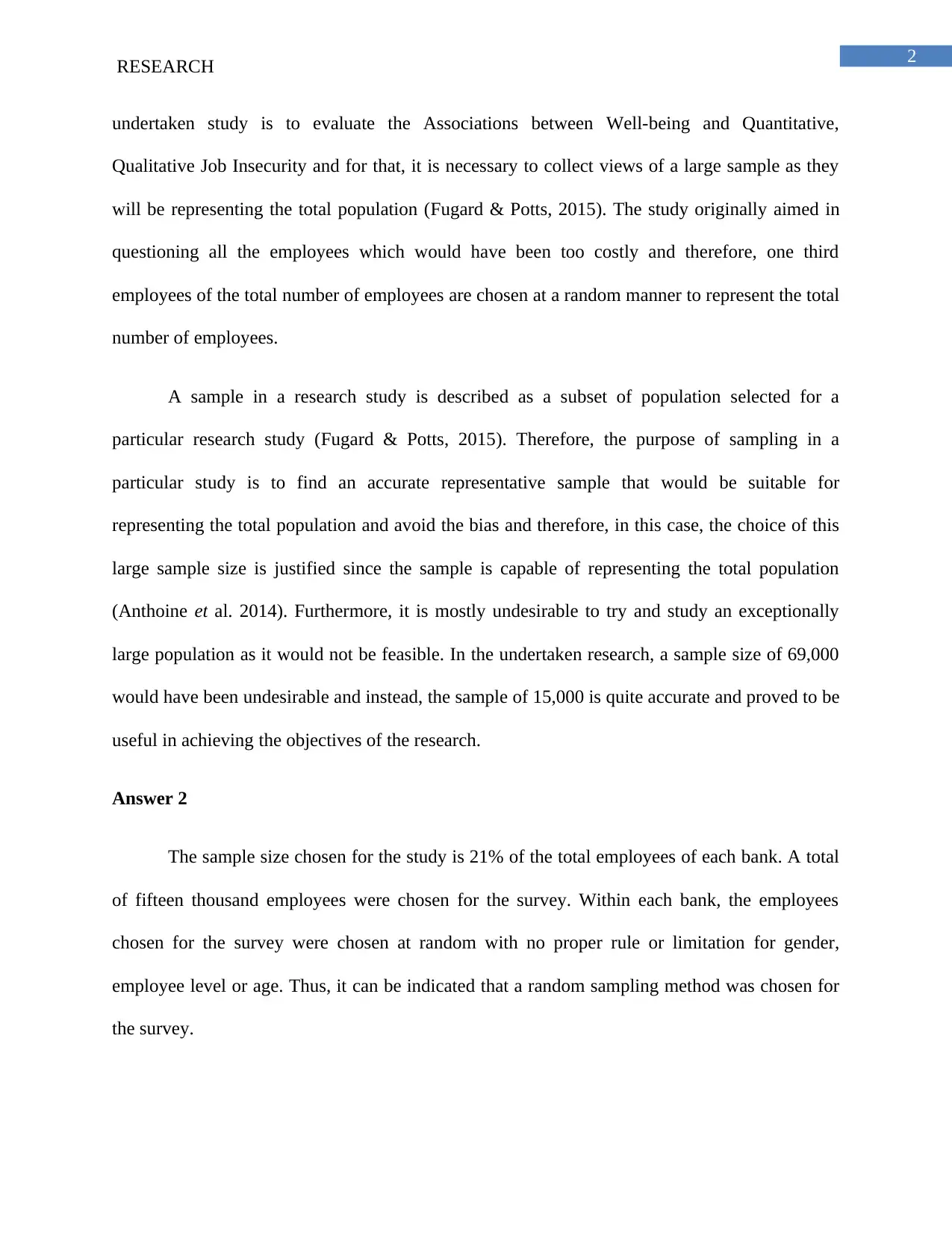
2
RESEARCH
undertaken study is to evaluate the Associations between Well-being and Quantitative,
Qualitative Job Insecurity and for that, it is necessary to collect views of a large sample as they
will be representing the total population (Fugard & Potts, 2015). The study originally aimed in
questioning all the employees which would have been too costly and therefore, one third
employees of the total number of employees are chosen at a random manner to represent the total
number of employees.
A sample in a research study is described as a subset of population selected for a
particular research study (Fugard & Potts, 2015). Therefore, the purpose of sampling in a
particular study is to find an accurate representative sample that would be suitable for
representing the total population and avoid the bias and therefore, in this case, the choice of this
large sample size is justified since the sample is capable of representing the total population
(Anthoine et al. 2014). Furthermore, it is mostly undesirable to try and study an exceptionally
large population as it would not be feasible. In the undertaken research, a sample size of 69,000
would have been undesirable and instead, the sample of 15,000 is quite accurate and proved to be
useful in achieving the objectives of the research.
Answer 2
The sample size chosen for the study is 21% of the total employees of each bank. A total
of fifteen thousand employees were chosen for the survey. Within each bank, the employees
chosen for the survey were chosen at random with no proper rule or limitation for gender,
employee level or age. Thus, it can be indicated that a random sampling method was chosen for
the survey.
RESEARCH
undertaken study is to evaluate the Associations between Well-being and Quantitative,
Qualitative Job Insecurity and for that, it is necessary to collect views of a large sample as they
will be representing the total population (Fugard & Potts, 2015). The study originally aimed in
questioning all the employees which would have been too costly and therefore, one third
employees of the total number of employees are chosen at a random manner to represent the total
number of employees.
A sample in a research study is described as a subset of population selected for a
particular research study (Fugard & Potts, 2015). Therefore, the purpose of sampling in a
particular study is to find an accurate representative sample that would be suitable for
representing the total population and avoid the bias and therefore, in this case, the choice of this
large sample size is justified since the sample is capable of representing the total population
(Anthoine et al. 2014). Furthermore, it is mostly undesirable to try and study an exceptionally
large population as it would not be feasible. In the undertaken research, a sample size of 69,000
would have been undesirable and instead, the sample of 15,000 is quite accurate and proved to be
useful in achieving the objectives of the research.
Answer 2
The sample size chosen for the study is 21% of the total employees of each bank. A total
of fifteen thousand employees were chosen for the survey. Within each bank, the employees
chosen for the survey were chosen at random with no proper rule or limitation for gender,
employee level or age. Thus, it can be indicated that a random sampling method was chosen for
the survey.
⊘ This is a preview!⊘
Do you want full access?
Subscribe today to unlock all pages.

Trusted by 1+ million students worldwide
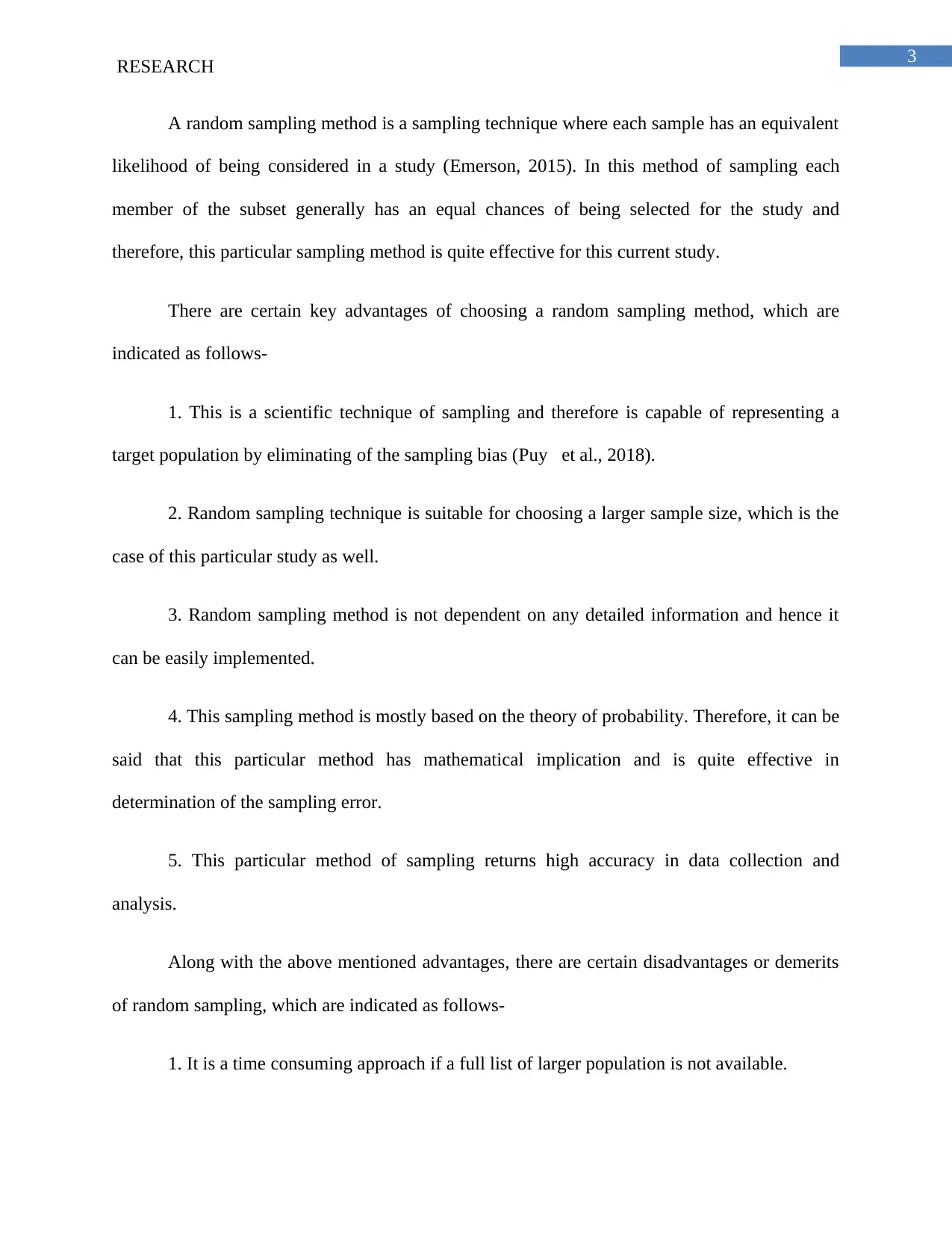
3
RESEARCH
A random sampling method is a sampling technique where each sample has an equivalent
likelihood of being considered in a study (Emerson, 2015). In this method of sampling each
member of the subset generally has an equal chances of being selected for the study and
therefore, this particular sampling method is quite effective for this current study.
There are certain key advantages of choosing a random sampling method, which are
indicated as follows-
1. This is a scientific technique of sampling and therefore is capable of representing a
target population by eliminating of the sampling bias (Puy et al., 2018).
2. Random sampling technique is suitable for choosing a larger sample size, which is the
case of this particular study as well.
3. Random sampling method is not dependent on any detailed information and hence it
can be easily implemented.
4. This sampling method is mostly based on the theory of probability. Therefore, it can be
said that this particular method has mathematical implication and is quite effective in
determination of the sampling error.
5. This particular method of sampling returns high accuracy in data collection and
analysis.
Along with the above mentioned advantages, there are certain disadvantages or demerits
of random sampling, which are indicated as follows-
1. It is a time consuming approach if a full list of larger population is not available.
RESEARCH
A random sampling method is a sampling technique where each sample has an equivalent
likelihood of being considered in a study (Emerson, 2015). In this method of sampling each
member of the subset generally has an equal chances of being selected for the study and
therefore, this particular sampling method is quite effective for this current study.
There are certain key advantages of choosing a random sampling method, which are
indicated as follows-
1. This is a scientific technique of sampling and therefore is capable of representing a
target population by eliminating of the sampling bias (Puy et al., 2018).
2. Random sampling technique is suitable for choosing a larger sample size, which is the
case of this particular study as well.
3. Random sampling method is not dependent on any detailed information and hence it
can be easily implemented.
4. This sampling method is mostly based on the theory of probability. Therefore, it can be
said that this particular method has mathematical implication and is quite effective in
determination of the sampling error.
5. This particular method of sampling returns high accuracy in data collection and
analysis.
Along with the above mentioned advantages, there are certain disadvantages or demerits
of random sampling, which are indicated as follows-
1. It is a time consuming approach if a full list of larger population is not available.
Paraphrase This Document
Need a fresh take? Get an instant paraphrase of this document with our AI Paraphraser
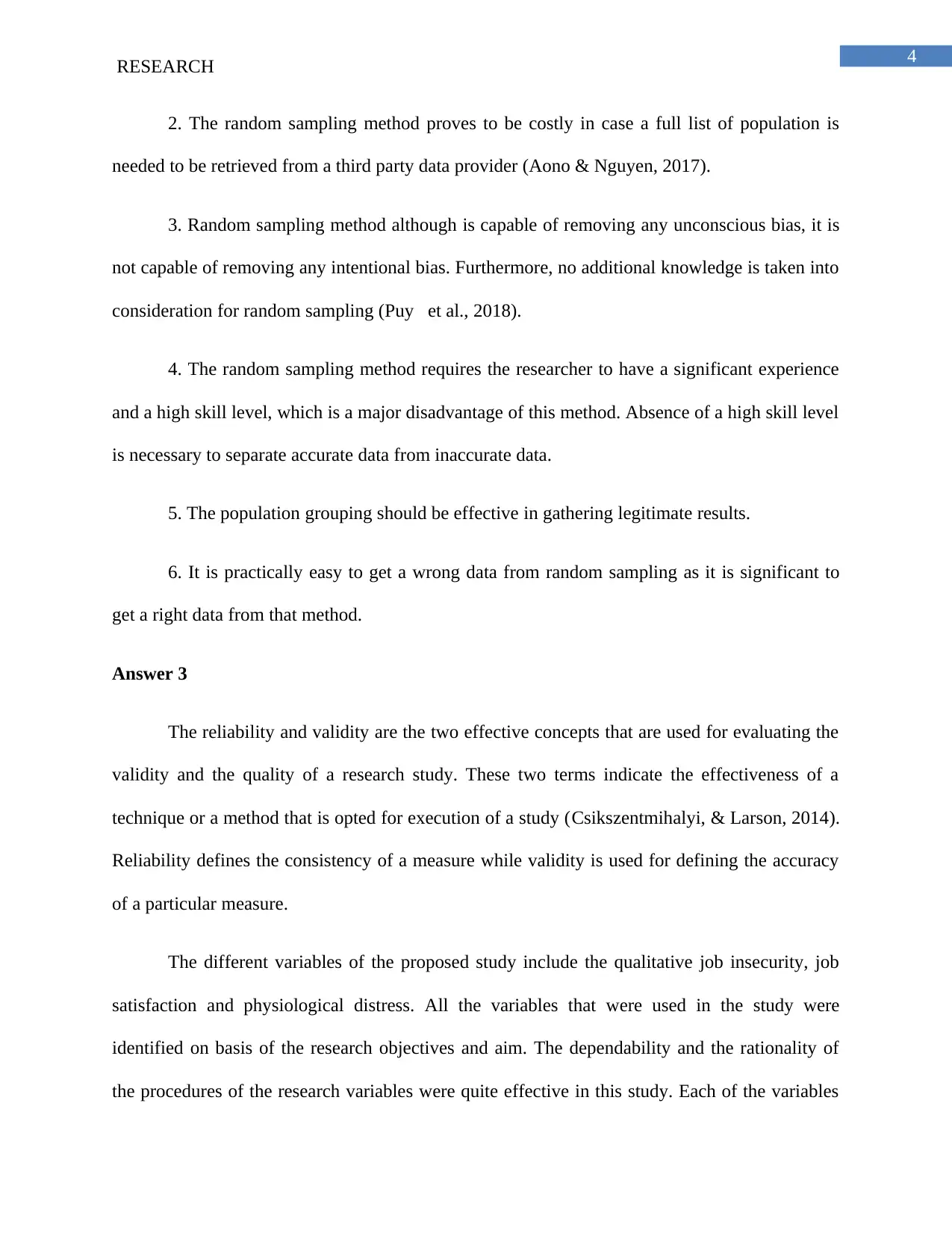
4
RESEARCH
2. The random sampling method proves to be costly in case a full list of population is
needed to be retrieved from a third party data provider (Aono & Nguyen, 2017).
3. Random sampling method although is capable of removing any unconscious bias, it is
not capable of removing any intentional bias. Furthermore, no additional knowledge is taken into
consideration for random sampling (Puy et al., 2018).
4. The random sampling method requires the researcher to have a significant experience
and a high skill level, which is a major disadvantage of this method. Absence of a high skill level
is necessary to separate accurate data from inaccurate data.
5. The population grouping should be effective in gathering legitimate results.
6. It is practically easy to get a wrong data from random sampling as it is significant to
get a right data from that method.
Answer 3
The reliability and validity are the two effective concepts that are used for evaluating the
validity and the quality of a research study. These two terms indicate the effectiveness of a
technique or a method that is opted for execution of a study (Csikszentmihalyi, & Larson, 2014).
Reliability defines the consistency of a measure while validity is used for defining the accuracy
of a particular measure.
The different variables of the proposed study include the qualitative job insecurity, job
satisfaction and physiological distress. All the variables that were used in the study were
identified on basis of the research objectives and aim. The dependability and the rationality of
the procedures of the research variables were quite effective in this study. Each of the variables
RESEARCH
2. The random sampling method proves to be costly in case a full list of population is
needed to be retrieved from a third party data provider (Aono & Nguyen, 2017).
3. Random sampling method although is capable of removing any unconscious bias, it is
not capable of removing any intentional bias. Furthermore, no additional knowledge is taken into
consideration for random sampling (Puy et al., 2018).
4. The random sampling method requires the researcher to have a significant experience
and a high skill level, which is a major disadvantage of this method. Absence of a high skill level
is necessary to separate accurate data from inaccurate data.
5. The population grouping should be effective in gathering legitimate results.
6. It is practically easy to get a wrong data from random sampling as it is significant to
get a right data from that method.
Answer 3
The reliability and validity are the two effective concepts that are used for evaluating the
validity and the quality of a research study. These two terms indicate the effectiveness of a
technique or a method that is opted for execution of a study (Csikszentmihalyi, & Larson, 2014).
Reliability defines the consistency of a measure while validity is used for defining the accuracy
of a particular measure.
The different variables of the proposed study include the qualitative job insecurity, job
satisfaction and physiological distress. All the variables that were used in the study were
identified on basis of the research objectives and aim. The dependability and the rationality of
the procedures of the research variables were quite effective in this study. Each of the variables
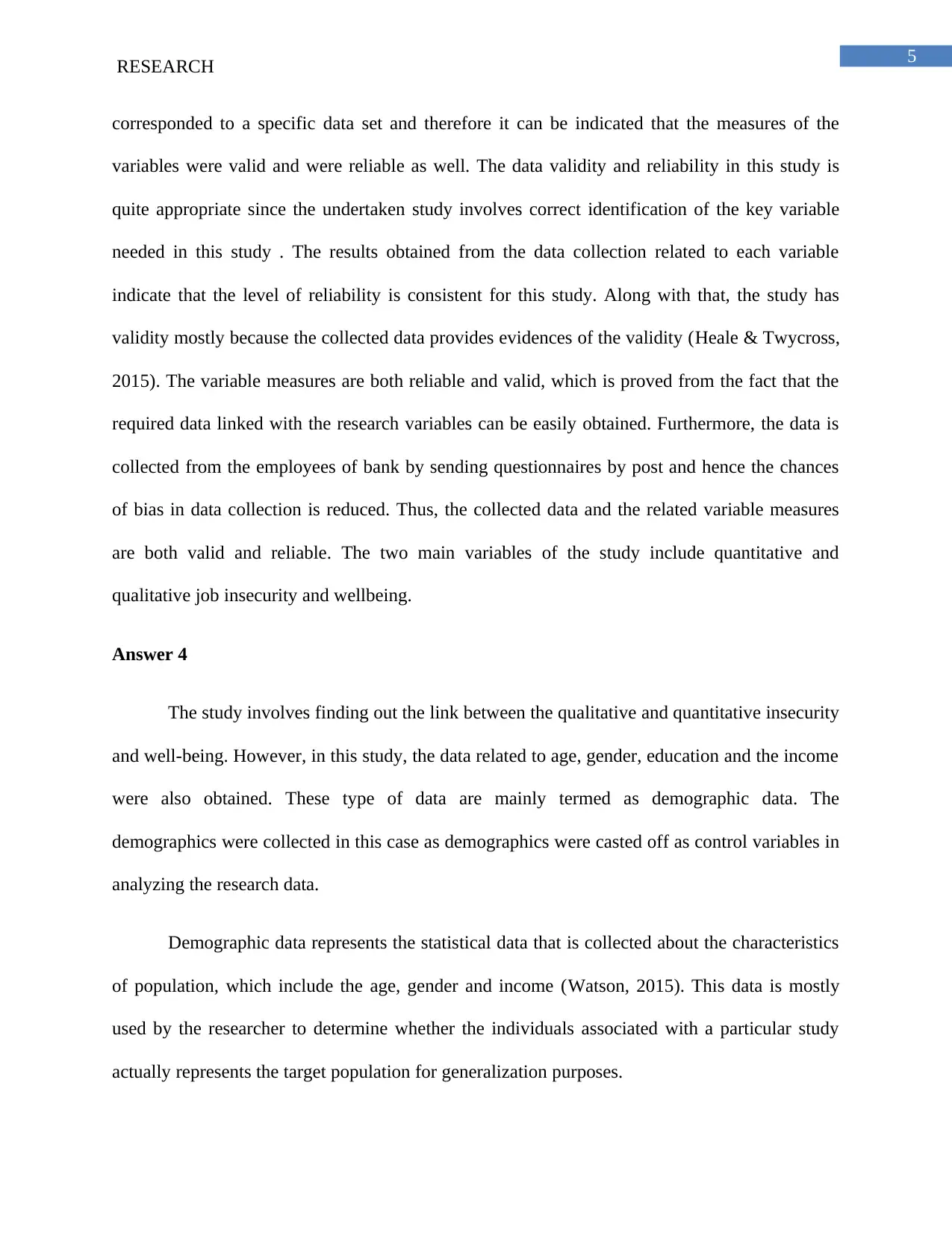
5
RESEARCH
corresponded to a specific data set and therefore it can be indicated that the measures of the
variables were valid and were reliable as well. The data validity and reliability in this study is
quite appropriate since the undertaken study involves correct identification of the key variable
needed in this study . The results obtained from the data collection related to each variable
indicate that the level of reliability is consistent for this study. Along with that, the study has
validity mostly because the collected data provides evidences of the validity (Heale & Twycross,
2015). The variable measures are both reliable and valid, which is proved from the fact that the
required data linked with the research variables can be easily obtained. Furthermore, the data is
collected from the employees of bank by sending questionnaires by post and hence the chances
of bias in data collection is reduced. Thus, the collected data and the related variable measures
are both valid and reliable. The two main variables of the study include quantitative and
qualitative job insecurity and wellbeing.
Answer 4
The study involves finding out the link between the qualitative and quantitative insecurity
and well-being. However, in this study, the data related to age, gender, education and the income
were also obtained. These type of data are mainly termed as demographic data. The
demographics were collected in this case as demographics were casted off as control variables in
analyzing the research data.
Demographic data represents the statistical data that is collected about the characteristics
of population, which include the age, gender and income (Watson, 2015). This data is mostly
used by the researcher to determine whether the individuals associated with a particular study
actually represents the target population for generalization purposes.
RESEARCH
corresponded to a specific data set and therefore it can be indicated that the measures of the
variables were valid and were reliable as well. The data validity and reliability in this study is
quite appropriate since the undertaken study involves correct identification of the key variable
needed in this study . The results obtained from the data collection related to each variable
indicate that the level of reliability is consistent for this study. Along with that, the study has
validity mostly because the collected data provides evidences of the validity (Heale & Twycross,
2015). The variable measures are both reliable and valid, which is proved from the fact that the
required data linked with the research variables can be easily obtained. Furthermore, the data is
collected from the employees of bank by sending questionnaires by post and hence the chances
of bias in data collection is reduced. Thus, the collected data and the related variable measures
are both valid and reliable. The two main variables of the study include quantitative and
qualitative job insecurity and wellbeing.
Answer 4
The study involves finding out the link between the qualitative and quantitative insecurity
and well-being. However, in this study, the data related to age, gender, education and the income
were also obtained. These type of data are mainly termed as demographic data. The
demographics were collected in this case as demographics were casted off as control variables in
analyzing the research data.
Demographic data represents the statistical data that is collected about the characteristics
of population, which include the age, gender and income (Watson, 2015). This data is mostly
used by the researcher to determine whether the individuals associated with a particular study
actually represents the target population for generalization purposes.
⊘ This is a preview!⊘
Do you want full access?
Subscribe today to unlock all pages.

Trusted by 1+ million students worldwide
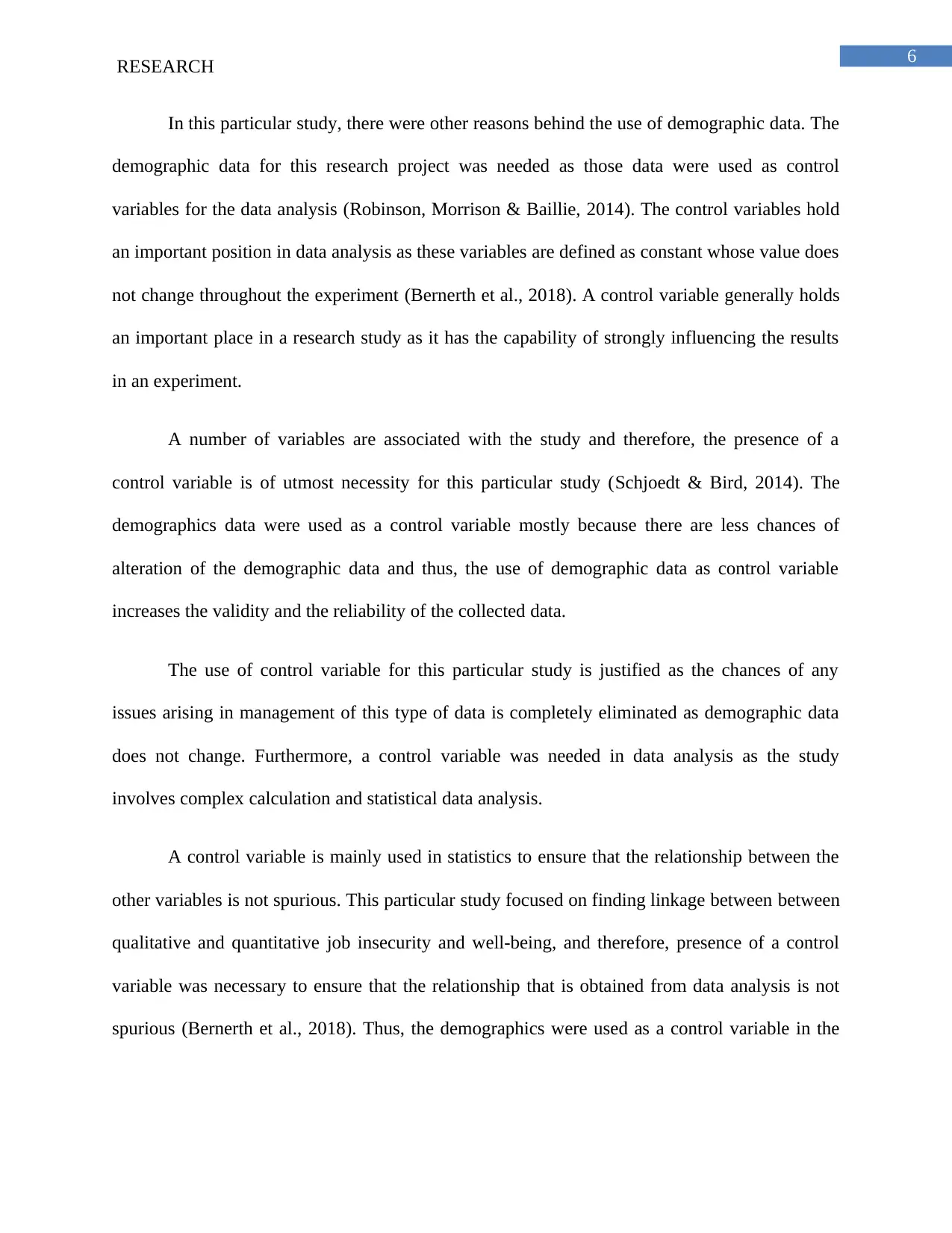
6
RESEARCH
In this particular study, there were other reasons behind the use of demographic data. The
demographic data for this research project was needed as those data were used as control
variables for the data analysis (Robinson, Morrison & Baillie, 2014). The control variables hold
an important position in data analysis as these variables are defined as constant whose value does
not change throughout the experiment (Bernerth et al., 2018). A control variable generally holds
an important place in a research study as it has the capability of strongly influencing the results
in an experiment.
A number of variables are associated with the study and therefore, the presence of a
control variable is of utmost necessity for this particular study (Schjoedt & Bird, 2014). The
demographics data were used as a control variable mostly because there are less chances of
alteration of the demographic data and thus, the use of demographic data as control variable
increases the validity and the reliability of the collected data.
The use of control variable for this particular study is justified as the chances of any
issues arising in management of this type of data is completely eliminated as demographic data
does not change. Furthermore, a control variable was needed in data analysis as the study
involves complex calculation and statistical data analysis.
A control variable is mainly used in statistics to ensure that the relationship between the
other variables is not spurious. This particular study focused on finding linkage between between
qualitative and quantitative job insecurity and well-being, and therefore, presence of a control
variable was necessary to ensure that the relationship that is obtained from data analysis is not
spurious (Bernerth et al., 2018). Thus, the demographics were used as a control variable in the
RESEARCH
In this particular study, there were other reasons behind the use of demographic data. The
demographic data for this research project was needed as those data were used as control
variables for the data analysis (Robinson, Morrison & Baillie, 2014). The control variables hold
an important position in data analysis as these variables are defined as constant whose value does
not change throughout the experiment (Bernerth et al., 2018). A control variable generally holds
an important place in a research study as it has the capability of strongly influencing the results
in an experiment.
A number of variables are associated with the study and therefore, the presence of a
control variable is of utmost necessity for this particular study (Schjoedt & Bird, 2014). The
demographics data were used as a control variable mostly because there are less chances of
alteration of the demographic data and thus, the use of demographic data as control variable
increases the validity and the reliability of the collected data.
The use of control variable for this particular study is justified as the chances of any
issues arising in management of this type of data is completely eliminated as demographic data
does not change. Furthermore, a control variable was needed in data analysis as the study
involves complex calculation and statistical data analysis.
A control variable is mainly used in statistics to ensure that the relationship between the
other variables is not spurious. This particular study focused on finding linkage between between
qualitative and quantitative job insecurity and well-being, and therefore, presence of a control
variable was necessary to ensure that the relationship that is obtained from data analysis is not
spurious (Bernerth et al., 2018). Thus, the demographics were used as a control variable in the
Paraphrase This Document
Need a fresh take? Get an instant paraphrase of this document with our AI Paraphraser
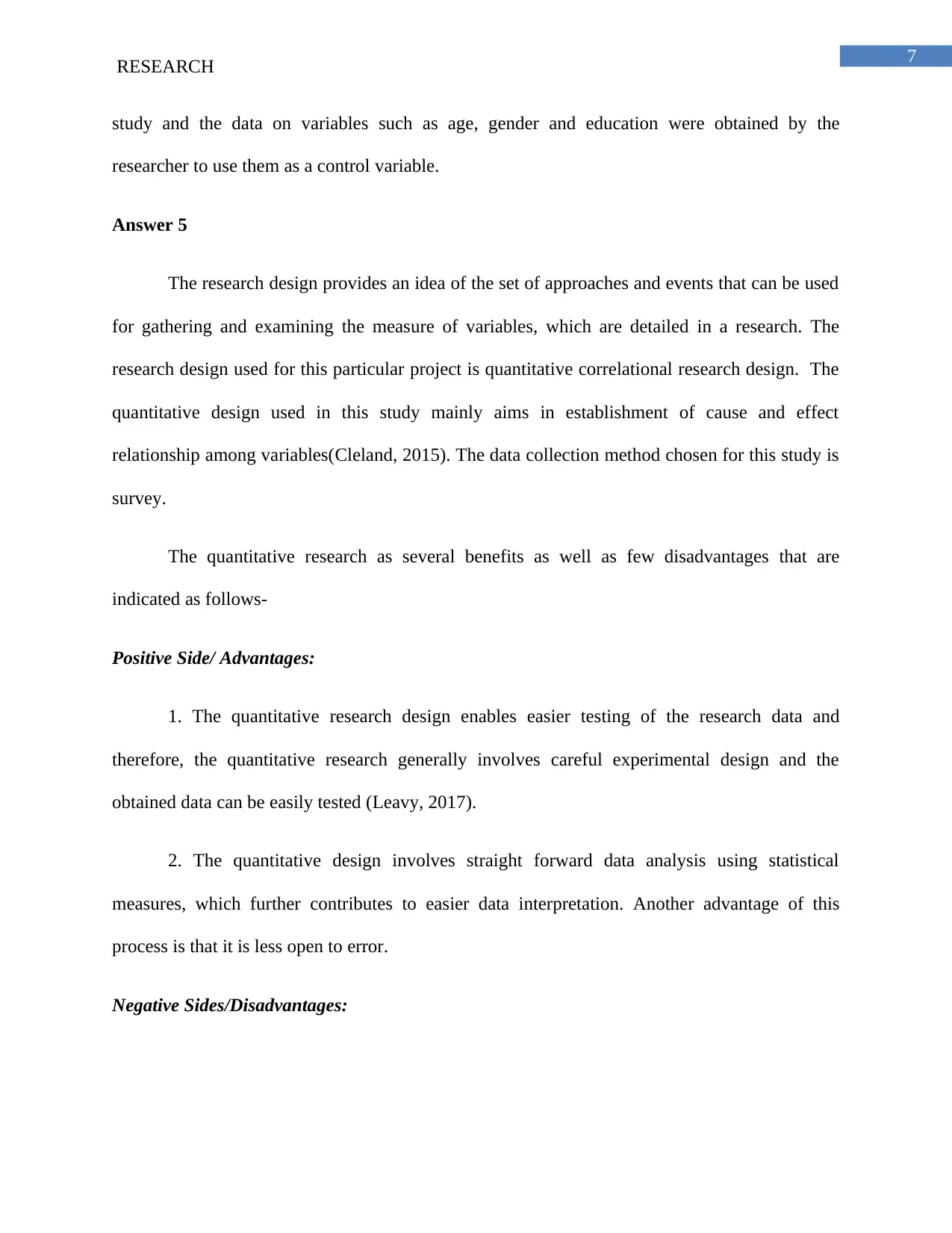
7
RESEARCH
study and the data on variables such as age, gender and education were obtained by the
researcher to use them as a control variable.
Answer 5
The research design provides an idea of the set of approaches and events that can be used
for gathering and examining the measure of variables, which are detailed in a research. The
research design used for this particular project is quantitative correlational research design. The
quantitative design used in this study mainly aims in establishment of cause and effect
relationship among variables(Cleland, 2015). The data collection method chosen for this study is
survey.
The quantitative research as several benefits as well as few disadvantages that are
indicated as follows-
Positive Side/ Advantages:
1. The quantitative research design enables easier testing of the research data and
therefore, the quantitative research generally involves careful experimental design and the
obtained data can be easily tested (Leavy, 2017).
2. The quantitative design involves straight forward data analysis using statistical
measures, which further contributes to easier data interpretation. Another advantage of this
process is that it is less open to error.
Negative Sides/Disadvantages:
RESEARCH
study and the data on variables such as age, gender and education were obtained by the
researcher to use them as a control variable.
Answer 5
The research design provides an idea of the set of approaches and events that can be used
for gathering and examining the measure of variables, which are detailed in a research. The
research design used for this particular project is quantitative correlational research design. The
quantitative design used in this study mainly aims in establishment of cause and effect
relationship among variables(Cleland, 2015). The data collection method chosen for this study is
survey.
The quantitative research as several benefits as well as few disadvantages that are
indicated as follows-
Positive Side/ Advantages:
1. The quantitative research design enables easier testing of the research data and
therefore, the quantitative research generally involves careful experimental design and the
obtained data can be easily tested (Leavy, 2017).
2. The quantitative design involves straight forward data analysis using statistical
measures, which further contributes to easier data interpretation. Another advantage of this
process is that it is less open to error.
Negative Sides/Disadvantages:
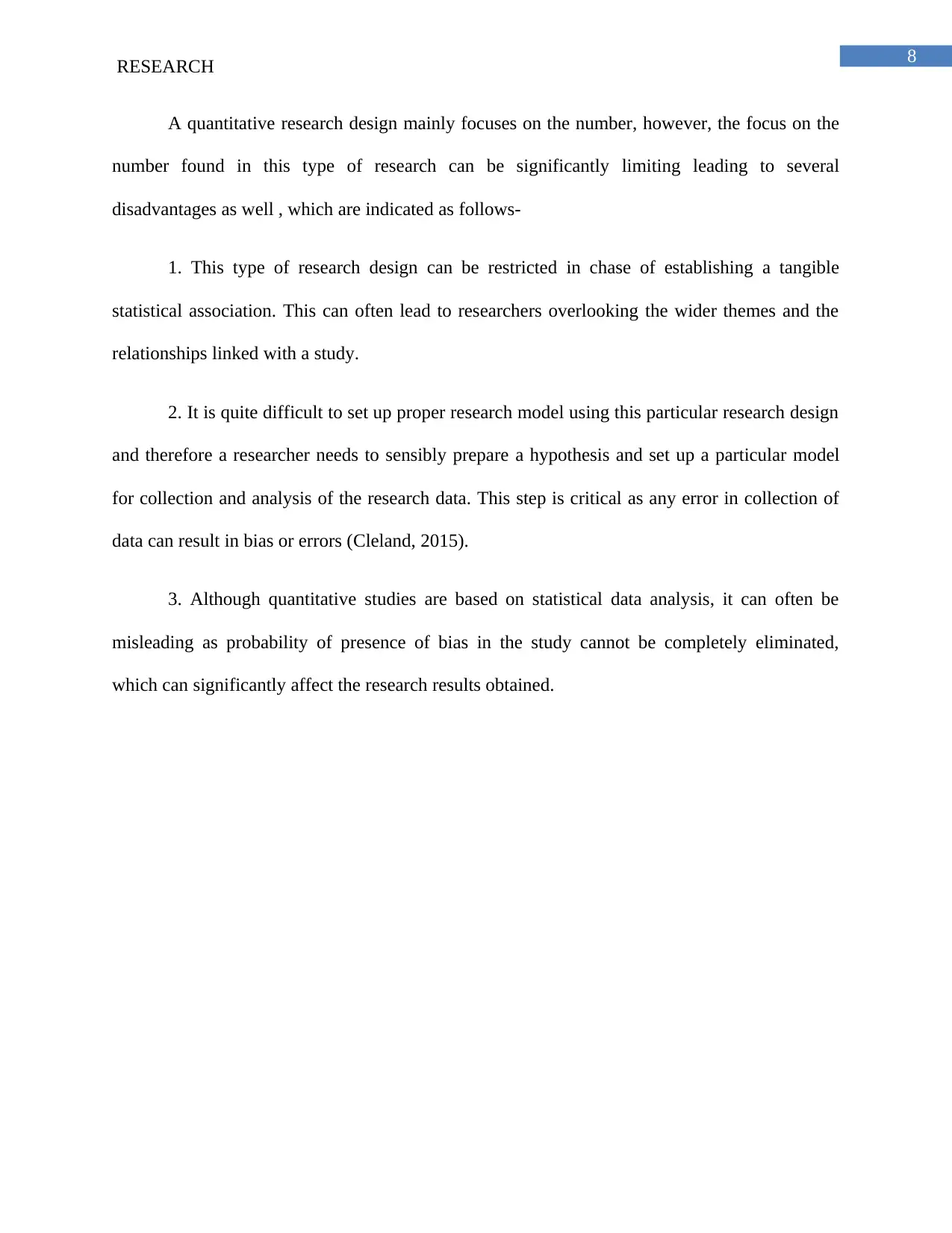
8
RESEARCH
A quantitative research design mainly focuses on the number, however, the focus on the
number found in this type of research can be significantly limiting leading to several
disadvantages as well , which are indicated as follows-
1. This type of research design can be restricted in chase of establishing a tangible
statistical association. This can often lead to researchers overlooking the wider themes and the
relationships linked with a study.
2. It is quite difficult to set up proper research model using this particular research design
and therefore a researcher needs to sensibly prepare a hypothesis and set up a particular model
for collection and analysis of the research data. This step is critical as any error in collection of
data can result in bias or errors (Cleland, 2015).
3. Although quantitative studies are based on statistical data analysis, it can often be
misleading as probability of presence of bias in the study cannot be completely eliminated,
which can significantly affect the research results obtained.
RESEARCH
A quantitative research design mainly focuses on the number, however, the focus on the
number found in this type of research can be significantly limiting leading to several
disadvantages as well , which are indicated as follows-
1. This type of research design can be restricted in chase of establishing a tangible
statistical association. This can often lead to researchers overlooking the wider themes and the
relationships linked with a study.
2. It is quite difficult to set up proper research model using this particular research design
and therefore a researcher needs to sensibly prepare a hypothesis and set up a particular model
for collection and analysis of the research data. This step is critical as any error in collection of
data can result in bias or errors (Cleland, 2015).
3. Although quantitative studies are based on statistical data analysis, it can often be
misleading as probability of presence of bias in the study cannot be completely eliminated,
which can significantly affect the research results obtained.
⊘ This is a preview!⊘
Do you want full access?
Subscribe today to unlock all pages.

Trusted by 1+ million students worldwide
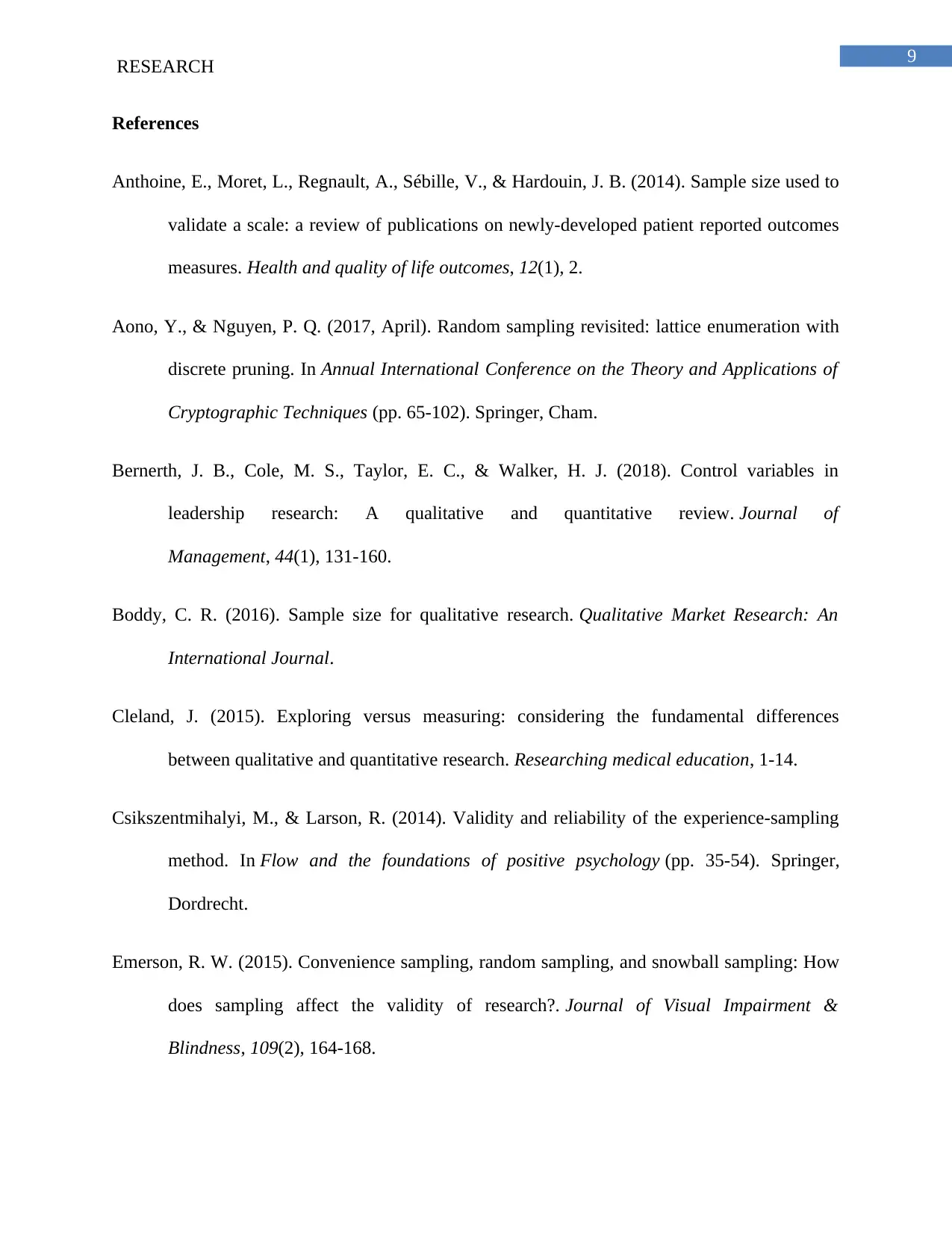
9
RESEARCH
References
Anthoine, E., Moret, L., Regnault, A., Sébille, V., & Hardouin, J. B. (2014). Sample size used to
validate a scale: a review of publications on newly-developed patient reported outcomes
measures. Health and quality of life outcomes, 12(1), 2.
Aono, Y., & Nguyen, P. Q. (2017, April). Random sampling revisited: lattice enumeration with
discrete pruning. In Annual International Conference on the Theory and Applications of
Cryptographic Techniques (pp. 65-102). Springer, Cham.
Bernerth, J. B., Cole, M. S., Taylor, E. C., & Walker, H. J. (2018). Control variables in
leadership research: A qualitative and quantitative review. Journal of
Management, 44(1), 131-160.
Boddy, C. R. (2016). Sample size for qualitative research. Qualitative Market Research: An
International Journal.
Cleland, J. (2015). Exploring versus measuring: considering the fundamental differences
between qualitative and quantitative research. Researching medical education, 1-14.
Csikszentmihalyi, M., & Larson, R. (2014). Validity and reliability of the experience-sampling
method. In Flow and the foundations of positive psychology (pp. 35-54). Springer,
Dordrecht.
Emerson, R. W. (2015). Convenience sampling, random sampling, and snowball sampling: How
does sampling affect the validity of research?. Journal of Visual Impairment &
Blindness, 109(2), 164-168.
RESEARCH
References
Anthoine, E., Moret, L., Regnault, A., Sébille, V., & Hardouin, J. B. (2014). Sample size used to
validate a scale: a review of publications on newly-developed patient reported outcomes
measures. Health and quality of life outcomes, 12(1), 2.
Aono, Y., & Nguyen, P. Q. (2017, April). Random sampling revisited: lattice enumeration with
discrete pruning. In Annual International Conference on the Theory and Applications of
Cryptographic Techniques (pp. 65-102). Springer, Cham.
Bernerth, J. B., Cole, M. S., Taylor, E. C., & Walker, H. J. (2018). Control variables in
leadership research: A qualitative and quantitative review. Journal of
Management, 44(1), 131-160.
Boddy, C. R. (2016). Sample size for qualitative research. Qualitative Market Research: An
International Journal.
Cleland, J. (2015). Exploring versus measuring: considering the fundamental differences
between qualitative and quantitative research. Researching medical education, 1-14.
Csikszentmihalyi, M., & Larson, R. (2014). Validity and reliability of the experience-sampling
method. In Flow and the foundations of positive psychology (pp. 35-54). Springer,
Dordrecht.
Emerson, R. W. (2015). Convenience sampling, random sampling, and snowball sampling: How
does sampling affect the validity of research?. Journal of Visual Impairment &
Blindness, 109(2), 164-168.
Paraphrase This Document
Need a fresh take? Get an instant paraphrase of this document with our AI Paraphraser
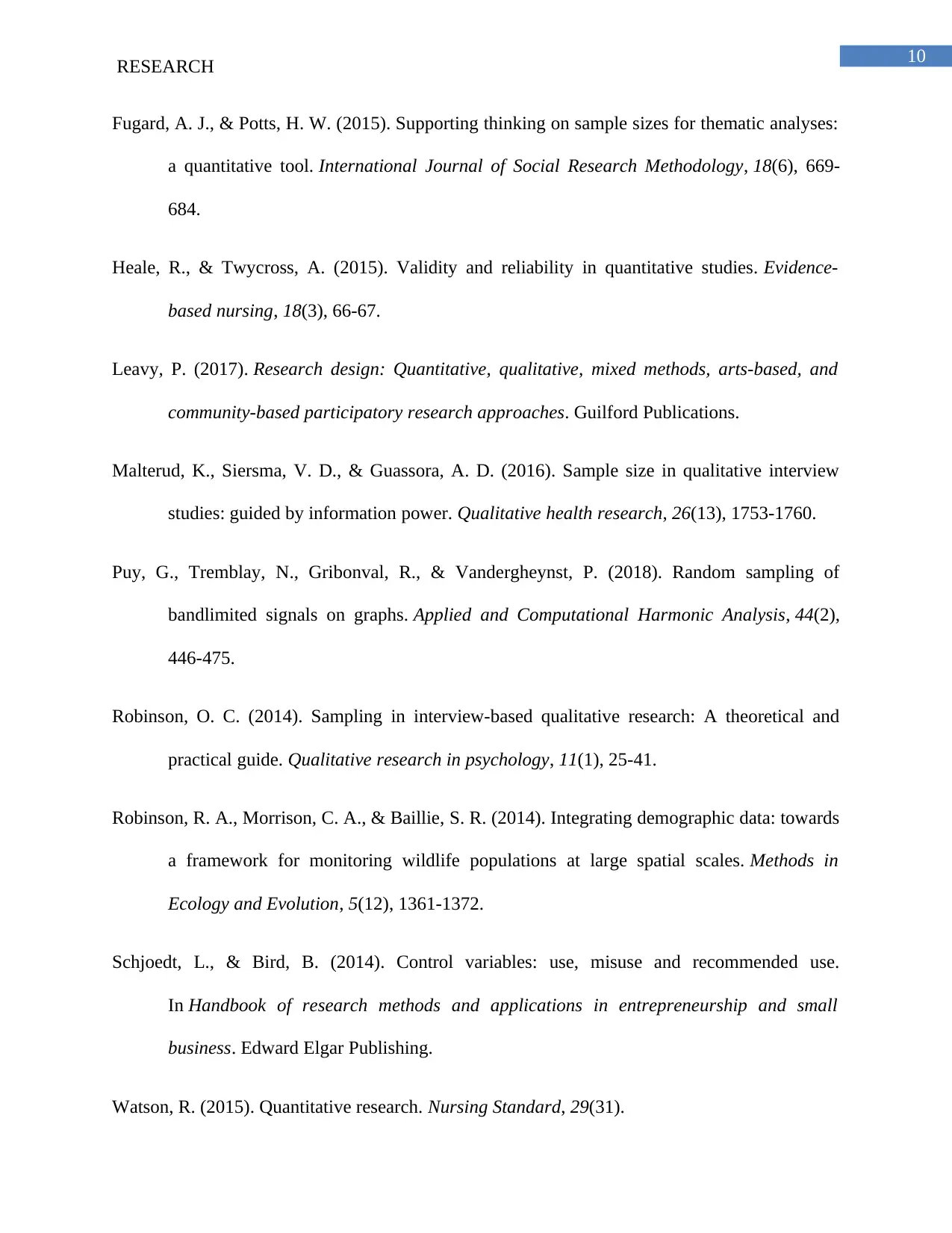
10
RESEARCH
Fugard, A. J., & Potts, H. W. (2015). Supporting thinking on sample sizes for thematic analyses:
a quantitative tool. International Journal of Social Research Methodology, 18(6), 669-
684.
Heale, R., & Twycross, A. (2015). Validity and reliability in quantitative studies. Evidence-
based nursing, 18(3), 66-67.
Leavy, P. (2017). Research design: Quantitative, qualitative, mixed methods, arts-based, and
community-based participatory research approaches. Guilford Publications.
Malterud, K., Siersma, V. D., & Guassora, A. D. (2016). Sample size in qualitative interview
studies: guided by information power. Qualitative health research, 26(13), 1753-1760.
Puy, G., Tremblay, N., Gribonval, R., & Vandergheynst, P. (2018). Random sampling of
bandlimited signals on graphs. Applied and Computational Harmonic Analysis, 44(2),
446-475.
Robinson, O. C. (2014). Sampling in interview-based qualitative research: A theoretical and
practical guide. Qualitative research in psychology, 11(1), 25-41.
Robinson, R. A., Morrison, C. A., & Baillie, S. R. (2014). Integrating demographic data: towards
a framework for monitoring wildlife populations at large spatial scales. Methods in
Ecology and Evolution, 5(12), 1361-1372.
Schjoedt, L., & Bird, B. (2014). Control variables: use, misuse and recommended use.
In Handbook of research methods and applications in entrepreneurship and small
business. Edward Elgar Publishing.
Watson, R. (2015). Quantitative research. Nursing Standard, 29(31).
RESEARCH
Fugard, A. J., & Potts, H. W. (2015). Supporting thinking on sample sizes for thematic analyses:
a quantitative tool. International Journal of Social Research Methodology, 18(6), 669-
684.
Heale, R., & Twycross, A. (2015). Validity and reliability in quantitative studies. Evidence-
based nursing, 18(3), 66-67.
Leavy, P. (2017). Research design: Quantitative, qualitative, mixed methods, arts-based, and
community-based participatory research approaches. Guilford Publications.
Malterud, K., Siersma, V. D., & Guassora, A. D. (2016). Sample size in qualitative interview
studies: guided by information power. Qualitative health research, 26(13), 1753-1760.
Puy, G., Tremblay, N., Gribonval, R., & Vandergheynst, P. (2018). Random sampling of
bandlimited signals on graphs. Applied and Computational Harmonic Analysis, 44(2),
446-475.
Robinson, O. C. (2014). Sampling in interview-based qualitative research: A theoretical and
practical guide. Qualitative research in psychology, 11(1), 25-41.
Robinson, R. A., Morrison, C. A., & Baillie, S. R. (2014). Integrating demographic data: towards
a framework for monitoring wildlife populations at large spatial scales. Methods in
Ecology and Evolution, 5(12), 1361-1372.
Schjoedt, L., & Bird, B. (2014). Control variables: use, misuse and recommended use.
In Handbook of research methods and applications in entrepreneurship and small
business. Edward Elgar Publishing.
Watson, R. (2015). Quantitative research. Nursing Standard, 29(31).

11
RESEARCH
RESEARCH
⊘ This is a preview!⊘
Do you want full access?
Subscribe today to unlock all pages.

Trusted by 1+ million students worldwide
1 out of 12
Related Documents
Your All-in-One AI-Powered Toolkit for Academic Success.
+13062052269
info@desklib.com
Available 24*7 on WhatsApp / Email
![[object Object]](/_next/static/media/star-bottom.7253800d.svg)
Unlock your academic potential
Copyright © 2020–2025 A2Z Services. All Rights Reserved. Developed and managed by ZUCOL.




